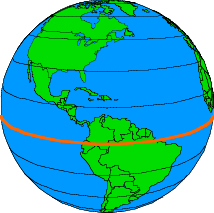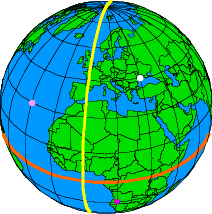 |
Positioning and Timing |
Positioning and Timing
Position on the Earth: The location on the surface of the Earth. The position can be expressed in several different ways, that is, in several coordinate systems. Latitude and longitude is one way of defining a position on the Earth, and is very popular worldwide too.
Latitude and Longitude: Latitude and longitude are the two axes of a particular system of coordinates that can be used to define a position on the surface of the Earth. Latitude and longitude measure, in degrees, the angular distance from a predefined imaginary circle on the surface of the Earth. Latitude is the angular distance from the Earth’s equator and is expressed as either north or south. Longitude is the angular distance from the Greenwich meridian and is expressed as east or west.
On the globe below, lines of latitude are shown. The equator (latitude 0°) is indicated by an orange line. The lines are separated by 15°, so, for example, the lines in the Northern Hemisphere represent latitudes of N15°, N30°, N45°, N60°, and N75°. The latitude N90° represents the North Pole, and cannot be seen on the figure. In the Southern Hemisphere, the latitudes of S15°, S30°, and S45° can be seen.

On the globe below, lines of longitude are shown. The "Greenwich," or "Prime" Meridian (longitude 0°) is indicated by a yellow line. The lines are separated by 15°, so, for example, the lines in the Eastern Hemisphere represent longitudes of E15°, E30°, and so on. Similarly, in the Western Hemisphere, the longitudes of W15°, W30°, and so on are shown.

Below, we show lines of longitude and latitude simultaneously. Both longitude and latitude are used to specify the position, or location, of a point on the Earth. For example, the white dot is at longitude E30°, latitude N45°. The light pink dot is at longitude W30°, latitude N30°. The dark pink dot is at longitude E15°, latitude S15°.

Space Geodesy Group Harvard-Smithsonian Center for Astrophysics 60 Garden St, MS 42 Cambridge, MA 02138-1516